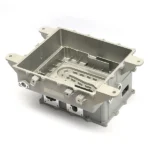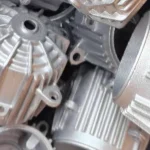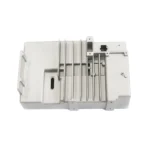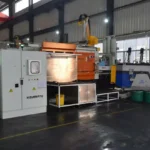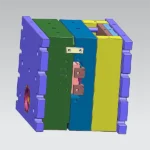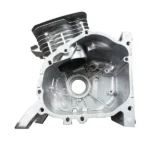
Feel free to contact us
Do You Have Any Questions?
Please see the questions below regarding die casting and die tooling. If you cannot find the answer you’re looking for, please don’t hesitate to send us your query, and we will respond as quickly as possible.
F.A.Qs
Frequently asked questions
H13 Steel – Most commonly used due to its resistance to thermal fatigue, high wear resistance, and strength at elevated temperatures.
P20 Steel – A more economical choice for molds with lower performance requirements.
S7 Steel – Ideal for molds subjected to heavy impact or shock loading.
420 Stainless Steel – Selected for corrosion-resistant molds.
1.2344 / AISI H13 – A premium choice for high-performance die casting applications.
Common metals used in die casting include aluminum, zinc, magnesium, copper, and lead alloys.
When requesting a quotation from a die-casting manufacturer, it’s crucial to provide detailed information to ensure an accurate and comprehensive quote. Here’s a list of key details you should offer:
1. Part Design or Drawing
Provide detailed CAD drawings or 3D models of the parts you wish to have die-cast. The drawings should include all dimensions, tolerances, and specific requirements.
2. Material Specifications
Specify the type of metal you want to use (e.g., aluminium, zinc, magnesium, or copper alloys). Include any specific material grades or standards.
3. Quantity
Indicate the required parts, such as how many pieces you need each month. These numbers will influence the price due to economies of scale in die casting. Be clear about whether you need a one-time order or ongoing production.
4. Surface Finish Requirements
Describe the required surface finish for the parts (e.g., smooth, textured, anodised, or powder-coated). Some finishes may necessitate additional processes or tooling.
5. Tolerance Requirements
Specify the dimensional tolerances and any specific features (e.g., holes, threads, or intricate details) that must be precisely manufactured.
6. Casting Process Type
Please specify if you need high-pressure die casting, low-pressure die casting, or another method. Each method may have different cost implications based on the part and material.
7. Tooling Requirements
Specify whether you need new tooling or the manufacturer can utilise existing tooling. If new tooling is required, ask about the costs and lead time associated with it.
8. Lead Time
Could you please share the delivery time you require? Ask the manufacturer about their lead time for the prototype and production run.
9. Assembly and Additional Processes
If you need the parts assembled or require secondary processes (e.g., machining, painting, or heat treatment), specify these requirements upfront.
10. Packaging and Delivery
Indicate any specific packaging requirements for shipping and whether you need the parts delivered to a specific location.
11. Quality Control and Certifications
If necessary, ask for specific certifications (e.g., ISO, ASTM) or quality control standards that should be met for the production of your parts.
12. Budget
Provide your budget range to help the manufacturer offer options within your cost constraints.
Providing this information upfront will help ensure the manufacturer can give you an accurate quote and help avoid delays or misunderstandings down the line.
- Die Design: The design of the die has a significant influence on casting flow. Features such as gate designs, runners, and sprue systems play a critical role in directing the molten metal into the cavity. A well-designed gating system ensures that the metal flows smoothly without obstruction or turbulence, resulting in a high-quality outcome.
- Injection Speed and Pressure: The speed and pressure of injecting molten metal into the die are key factors in controlling casting flow. Faster injection speeds can help fill the cavity more quickly, but excessive speed can cause turbulence, leading to air entrapment. The pressure must be high enough to ensure that the metal reaches all areas of the mold without causing excessive wear on the die.
- Molten Metal Temperature: The temperature of the molten metal also impacts its flow characteristics. If the metal is too cool, it may solidify too quickly, leading to incomplete filling or poor surface quality. Conversely, if the metal is too hot, it can cause excessive turbulence or oxidation. Maintaining the right temperature is essential for achieving smooth and controlled casting flow.
- Die Temperature and Cooling Rate: The temperature of the die and the cooling rate also affect casting flow. Rapid cooling can cause the metal to solidify prematurely, leading to defects such as shrinkage or poor surface finish. Conversely, a die that is too hot can lead to excessive metal flow, causing instability and defects in the final product.
- Alloy Type: Different alloys exhibit varying flow characteristics. For example, aluminum and zinc alloys have different viscosities and melting points, which affect how they flow during casting. Understanding the properties of the alloy being used is crucial for optimising casting flow.
Mould tolerance plays a critical role in the longevity of die-casting moulds, as it directly affects stress distribution, wear, and thermal expansion during the casting process.
- Material stresses: Tight tolerances in die-cast moulds lead to more precise fits between the mold and the molten metal. This process can increase internal emphasis on the mold and the cast parts. Over time, these stresses can cause the mold to deform or crack, particularly in high-pressure areas where the metal is injected.
- Wear and Tear: In die casting, high precision means less room for movement between the mold components. This tight fit can increase friction, accelerating wear and tear on the mold surfaces. Consequently, the mould may exhibit surface degradation, leading to defects in the cast parts and a reduced mould life.
- Thermal Expansion: Die casting involves high temperatures, causing the mold to experience rapid heating and cooling cycles. When tolerances are very tight, thermal expansion can induce additional stress. The increased strain from these temperature fluctuations may lead to premature wear, cracking, or even mould failure over time.
- Cavity Erosion: Tight tolerances in die-casting molds can lead to erosion in the cavity areas where molten metal is injected under high pressure. Over time, this erosion can compromise the shape of the mould, resulting in dimensional inaccuracies in the cast parts and necessitating more frequent maintenance or repairs.
- Maintenance Costs: Die-casting molds with tight tolerances require careful handling and frequent maintenance. Even minor deviations from the required tolerance can lead to defects in the cast parts, which can increase repair costs and reduce the mould’s overall lifespan.
In summary, tight tolerances are essential for achieving high-quality die castings but can also accelerate mold wear and reduce lifespan. Striking the right balance between precision and durability is key to maximising die-cast moulding life and minimising long-term maintenance costs.
There are several types of metal casting processes, including sand casting, investment casting, die casting, and centrifugal casting, each suitable for different applications and materials.
The lifespan of a die-cast mold depends on several factors, including the quality of materials, maintenance, mold design, and operating conditions, such as temperature and pressure.
Tight tolerances in the mold can improve part quality but may increase wear and tear, leading to more frequent maintenance and potentially a shorter lifespan.

Ask Us
Quick contact form

